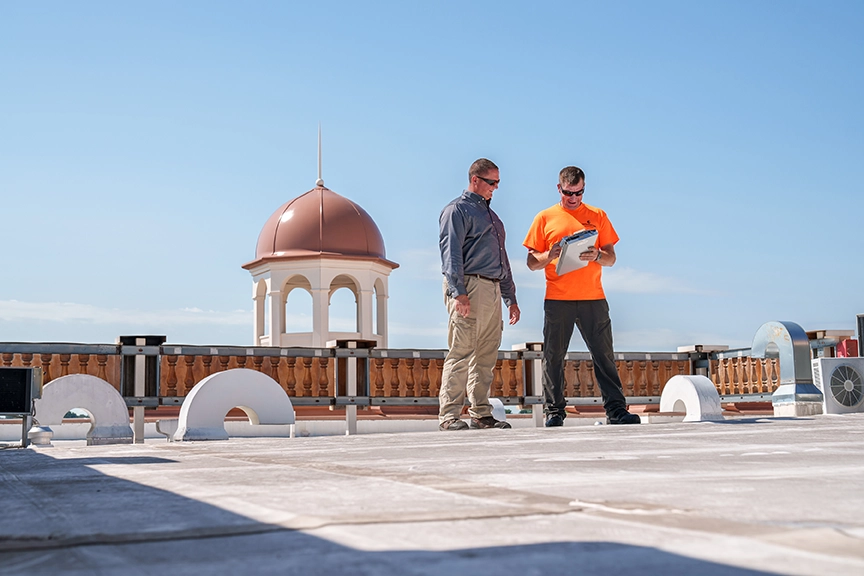Commercial Roof Repair vs. Replacement: When is it time for a new roof?
Your commercial roof has seen it all: rain, snow, ice, sleet, hail, wind, and UV rays from the sun. Without question, a commercial roof will sustain wear and tear over time. Weather, trees and shrubs, and equipment sitting on top of the roof are all potential culprits for damage, as well as birds, squirrels, and critters. And, unfortunately, if damage is not addressed promptly, small roof problems can develop into larger, more costly issues that can affect your commercial building’s structure and everything within it. So how do you answer this question: Can a roof be repaired instead of replaced?

That’s why it’s critical to have a professional roof inspection performed and to seek advice from qualified contractors or engineers to determine whether you should repair or replace your roof. Hiring a professional roofing company will ensure your roof gets the attention it needs to continue functioning optimally. Only roofing professionals can provide an accurate commercial roof assessment that will determine a roof’s condition and recommend the most appropriate course of action. Timely repairs can extend the life of a roof, giving you more time before needing to replace it, which will be expensive.
A reputable roofing repair company can fix roof issues including:
- Leaks, Tears, Cracks, and Punctures
- Standing Water on Flat Roofs
- Inefficient Drainage
- Rust on Metal Roofs
- Problems Caused by Poor Installation
But before you consult with a roofing professional, there are some factors you should consider. These dynamics can help you make an informed decision regarding roof repair vs. replacement and what is needed for your commercial roof.
Age of the Roof
If the roof is near the end of its expected lifespan, replacement might be a more cost-effective, long-term solution. Most commercial roofs have a lifespan of 20-30 years, but this can vary depending on what types of materials have been used.
Extent of Damage
A trained roofing professional can access the severity and extent of any roof damage that might be present. If the damage is localized and can be repaired, it might make sense to fix the problems, rather than replace an entire commercial roof. However, if there are widespread issues that could turn into a roofing emergency because they impact the building’s structural integrity or because the roof itself is compromised, replacement might be a better option.
Frequency of Repairs
If you find yourself repairing the same issues over and over again on your commercial roof, it’s a sign the roof is reaching the end of its life cycle. Roof replacement will be more economical in the long run.
Cost
Compare the costs of repairing the existing roof versus the cost of a full replacement. You should factor in potential long-term savings, energy efficiency, and maintenance costs associated with a new roof.
Energy Efficiency
Newer roofing materials and technologies may offer improved energy efficiency and environmental benefits. You should consider whether upgrading to a more modern roofing system aligns with your company’s goals and also check if the energy efficient roof you are considering is eligible for tax rebates.
Building Codes and Regulations
In addition, check if your current roof complies with the latest building codes and regulations. If not, a full replacement may be needed to meet those required standards.
Long-Term Plans
Consider the long-term plans you have for your property. If you plan to sell or lease it, a new roof might enhance the property’s value and appeal.
Insurance Considerations
Check with your insurance provider to determine if they have any requirements, conditions, or incentives for roof maintenance or replacement as some insurance policies may offer discounts for certain types of roofing materials or improvements.
After reviewing all of these considerations, if you feel a commercial roof replacement is the best option for your facility, you should work with a professional commercial roofing company. Be sure the business you select has experience with clients in a broad range of industries and with buildings of all kinds. Every structure has unique needs, so you need to select the roofing option that best suits your building’s construction and goals. There are several different roof types that can be considered. These include:
Single-Ply Roofs
Constructed of a flat polymer-based material, single-ply roofing creates a waterproof membrane over a facility’s roof. It’s a lightweight and flexible option that’s especially ideal for flat roofs. Materials used for single-ply roofing include EPDM coating, PVC, TPO roof coating, TPE, and PIB. Unlike other roofing matter, many single-ply materials can be partially or fully recycled, making them an eco-conscious choice as well.
Spray Foam Roofs
Spray polyurethane foam roofing is an economical replacement solution that conforms to all roof shapes. It provides high resistance to chemicals and has an insulating effect to improve energy efficiency.
Metal Roofs
Metal roofing has the benefits of superior fire resistance, low maintenance, and durability even under extreme weather conditions. It’s an attractive option for businesses looking for a long-term replacement solution that requires minimal upkeep.
Shingle Roofs
Asphalt shingle roofing can work well for both low-slope and steep-slope roofs when combined with proper underlayment to prevent leaking and water build-up. It’s a versatile, cost-effective, and aesthetic option for pitched roofs.
The decision to repair or replace a commercial roof is never easy. It involves evaluating the overall condition of the commercial roof, considering long-term costs, and factoring in the future plans for your property. Consulting with roofing professionals and having them conduct a thorough assessment will help you to determine if your roof should be repaired or replaced. And if you decide to replace your commercial roof, you should consider all of the roofing options available, so the best roofing material for your commercial facility is selected.